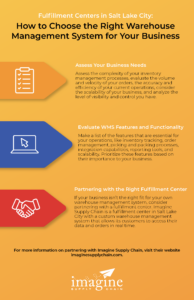“In 2022, 338 billion packages shipped worldwide,” says CapitalOne Shopping Research. At Imagine Supply Chain, we understand the challenges that come with managing a supply chain, especially during the summer months. From increased demand for seasonal products at fulfillment center to potential disruptions caused by weather events or global issues, summer can present lots of unique obstacles for supply chain professionals. In this article, we’ll talk about five strategies to help your organization deal with supply chain disruptions during the summer and build resilience for the future.
1. Diversify Sourcing and Distribution Channels
One of the key strategies for resilience in supply chain management is diversification. By diversifying your sourcing and distribution channels, you can help reduce the impact of disruptions in any one area. This may involve working with multiple suppliers for critical components or products, as well as exploring other transportation routes to avoid bottlenecks or delays.
At Imagine Supply Chain, we push for an approach to diversification. By continually looking at and optimizing your network of suppliers and distributors, you can build flexibility into your supply chain and adapt more effectively to changing conditions. This prepared stance can help limit risks and minimize the impact of disruptions on your operations, saving time and money in the long run.
2. Leverage Technology for Visibility and Transparency
In today’s interconnected supply chains, visibility and transparency are needed for effective management. Leveraging technology solutions such as supply chain management software and IoT-enabled devices can provide real-time insights into your operations, from raw material sourcing to final delivery.
At Imagine Supply Chain, we use technology platforms to enhance visibility and transparency throughout the supply chain. By tracking metrics and keeping an eye on critical processes, we can identify potential disruptions early and take measures to limit their impact. This data-driven approach helps us to make informed decisions and optimize our supply chain for resilience.
3. Strengthen Relationships with Partners and Suppliers
Strong relationships with partners and suppliers are another huge part of resilient supply chain management. Building trust and collaboration with your network of stakeholders can facilitate communication and coordination during challenging times.
According to Harvard, “Business relationships can come in many forms, but ultimately they are about advancing your goals, particularly within an organization. Pamela Rucker, instructor of Strengthening Business Relationships: Creating Strategic Alliances and Building Trust at Harvard Division of Continuing Education’s Professional & Executive Development, says that the way leaders perform their work changes as they advance in their careers. Leaders typically start off using their skills and intellect to manage their work based on their expertise. As they move up the ladder, their work becomes more complex; leaders may need insight, information, or input from others, or they may need to improve their team management skills. This is where business relationships are helpful. Having a trusted network with which to share ideas and ask questions can help develop leadership abilities for better outcomes.”
At Imagine Supply Chain, we like to focus on relationship-building as a strategic need. By having open lines of communication and addressing issues early on, we can work together with our partners to overcome disruptions and find creative solutions. This collaborative approach strengthens our supply chain resilience and enables us to adapt quickly to changing market conditions.
4. Implement Robust Risk Management Practices
Effective risk management is a big need when it comes to navigating supply chain disruptions, especially during the summer months when volatility can be heightened. Having a strong risk management practice involves identifying potential risks, assessing their impact, and developing contingency plans to mitigate them.
At Imagine Supply Chain, we take a comprehensive approach to risk management. We conduct risk assessments across our supply chain, evaluating factors such as supplier stability, transportation vulnerabilities, and market fluctuations. This risk identification allows us to anticipate challenges and implement proactive measures to minimize their impact on our operations.
5. Build Flexibility into Fulfillment Center Operations
The fulfillment center is a very important component of the supply chain, serving as the nexus where products are received, processed, and shipped to customers. Building flexibility into fulfillment center operations is essential for resilience, especially during peak seasons like summer.
At Imagine Supply Chain, we use our fulfillment center operations for flexibility and scalability. This includes training staff, implementing agile workflows, and leveraging automation technologies to enhance efficiency. By building flexibility into our fulfillment center operations, we can adapt quickly to fluctuations in demand and mitigate disruptions effectively.
Navigating supply chain disruptions during the summer months requires a multifaceted approach that balances proactive planning with adaptive strategies. By implementing the five strategies outlined—diversifying suppliers, leveraging technology, maintaining robust communication channels, optimizing inventory management, and investing in employee training—fulfillment centers can enhance their resilience against seasonal challenges. These measures not only help to limit risks associated with increased demand and potential disruptions but also position fulfillment centers to operate more efficiently and responsively. Ultimately, a well-prepared fulfillment center is better equipped to meet customer expectations, maintain operational continuity, and achieve long-term success.
At Imagine Supply Chain, we are committed to helping our clients navigate supply chain disruptions and build resilience for long-term success. By implementing these strategies in your fulfillment center and embracing a proactive approach to supply chain management, organizations can thrive even in the most challenging environments.



